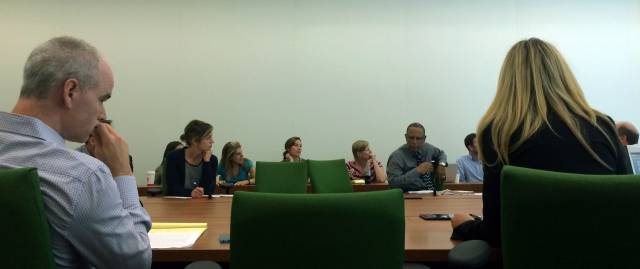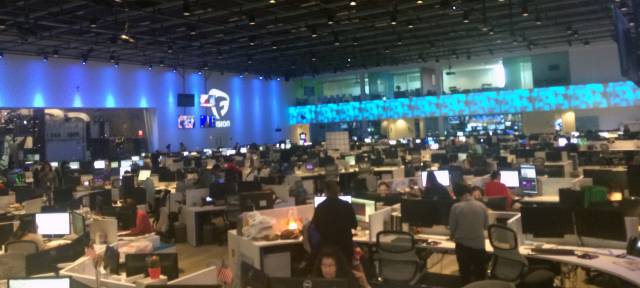NEW YORK and MIAMI.
“Washington, Paris… are you there?”
At the stroke of ten the editor of the New York Times checks the audio connection to the major bureaus from a crowded meeting room at the paper’s headquarter on 8th Avenue in New York.
Immediately after the connection is established, the editor draws attention to the online front pages of the digital products projected on the wall, to discuss what should lead on the website and apps. This is how the editorial meetings usually starts, explains Editor-in-chief Dean Baquet.
“We now try to make it the meeting, where we focus as much as possible on what the website should look like through the day,” Baquet says.
“The New York Times has changed tremendously over the last decade; when digital was an afterthought, now it’s increasingly the dominant way we think of our coverage and it’s the dominant way that people read us.”

Editorial meeting at the New York Times.
The change in priorities has also created new job titles. A couple of month ago the paper assigned a senior editor exclusively to get people to read the New York Times through social media and make sure that that they are not passively waiting for people to go to the homepage to read their content.
“It is a broad cultural change in the newsroom. Traditionally the newsroom didn’t get involved in reaching readers, we did great journalism and left that for someone else,” the Deputy International Editor, Michael Slackman adds.
“What we all recognize now is because of the explosion of social media and search engines, people find journalism in different ways. So we a now very deeply engaged in making sure that it gets out there.”
The Arab Spring changed the game
As technology changed and sparked new expectations among the readers, from being willing to wait for the print edition in the mailbox in the mornings to expecting the news right away, the newsroom has to change accordingly, says the Assistant Managing Editor of news and foreign editor for eight years at the New York Times Susan Chira.
“The turning point was 2011 in the Arab Spring. We had every editor on the foreign desk taking a different country and updating it live in order to provide the best reporting. So when Mubarak fell we didn’t just want to write that he fell, we wanted a New York Times story both with the history and the context as well as the news story,” Chira says.

Editor-in-chief Dean Baquet (right side) at the editorial meeting at the New York Times.
“We made sure that it was both deep, complex and in real time, because that was when readers read us. That was a paradigm shift.”
The New York Times had to significantly reorganize every way they did business and have the correspondents file in real-time. Before that, they believed that it was all right to be slow as long as they stayed smarter. The pressure for speed was simply not there.
But that has changed. The audience want the story here and now. That means that they have a dual commitment to be fast while still staying accurate and engaging.
“We established a 24 hour system of rewrite people, in Paris, Hong Kong and New York, so that the foreign correspondents quickly could debrief a rewrite person and keep doing the deep reporting they needed to do in order to proceed these fine stories that eventually would go in to print. Foreign correspondents became the early adapters,” Chira stated.
Good in ink probably splendid in binary code
According to the Vice President for digital media at the American Spanish language broadcast Univision News and former Nieman fellow at Harvard, Borja Echevarría, media companies can’t wait for a sustainable online business model before moving the newsroom towards adopting online news. If they do so, they most likely will be overtaken by other medias with a more hard-hitting digital strategy.
“Audiences change before the business models. Always. Just looking at our kids, we know what is going to happen. Kids want the news online and right away. The argument that I have heard in many newsrooms is that the business is in the legacy part [ie. in print or broadcast]”, Echevarria says.

Univisións Newsroom in Miami, Florida.
“But if you wait for the digital business model to be supportable, you have run out of time. Big media companies are slow and to move them takes a lot of time, so you have to start moving before its too late.”
Coming from a career in print in his home country Spain, Echevarría swapped to digital news in 2002. He became the deputy managing editor of El País, Spain’s largest daily newspaper in 2010, where he was responsible for the digital strategy and played a key role in the newspaper’s successful transformation.
“The way I changed the newsroom in El País was by bringing people from the offline world over to the online world of the paper. Keeping them there for some time and sending them back.”
One of his observations – and this might come as a relief for some – is that he finds it much easier to equip already skilled and experienced reporters with the necessary digital skills and mindset, than making an accomplished journalist out of tech-savvy employees who don’t possess core journalistic skills.
The upshot is the following: if you are a damn fine reporter in the old world of ink, radio waves or P2 cards, you most likely will succeed in the binary world of zeroes and ones.



